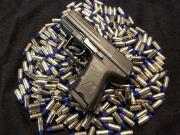I've heard some trainers, for example Kyle Lamb in this video, starting at about 1:15 :
say that when firing multiple shots on multiple targets, the split times between shots on a given target should be about the same as the transition time from target to target, so it sounds like a constant stream of shots. I've never really heard anyone explain why that's desirable. It seems to me you should just do everything as fast as you can with acceptable accuracy. Thoughts?



 Reply With Quote
Reply With Quote



